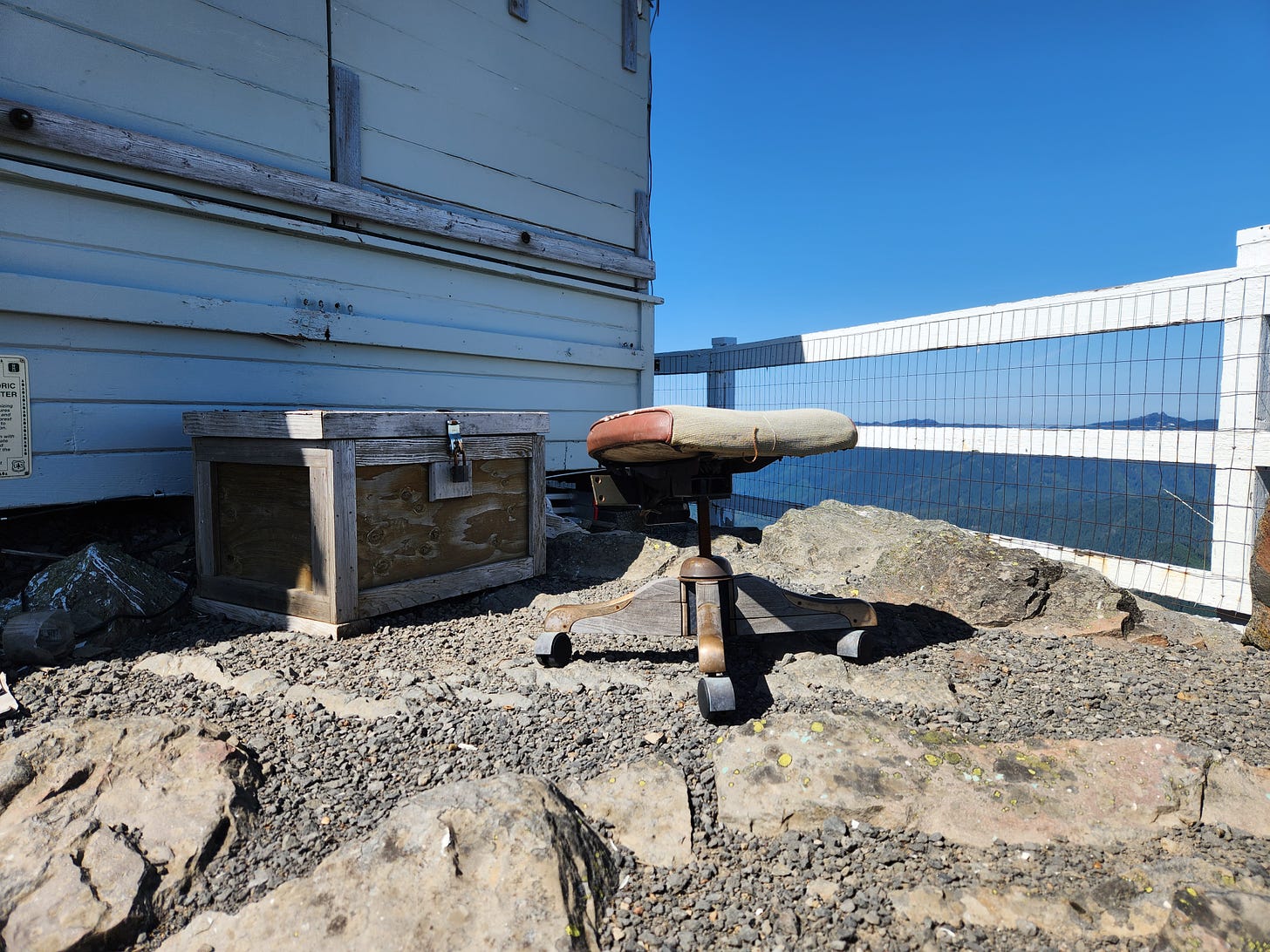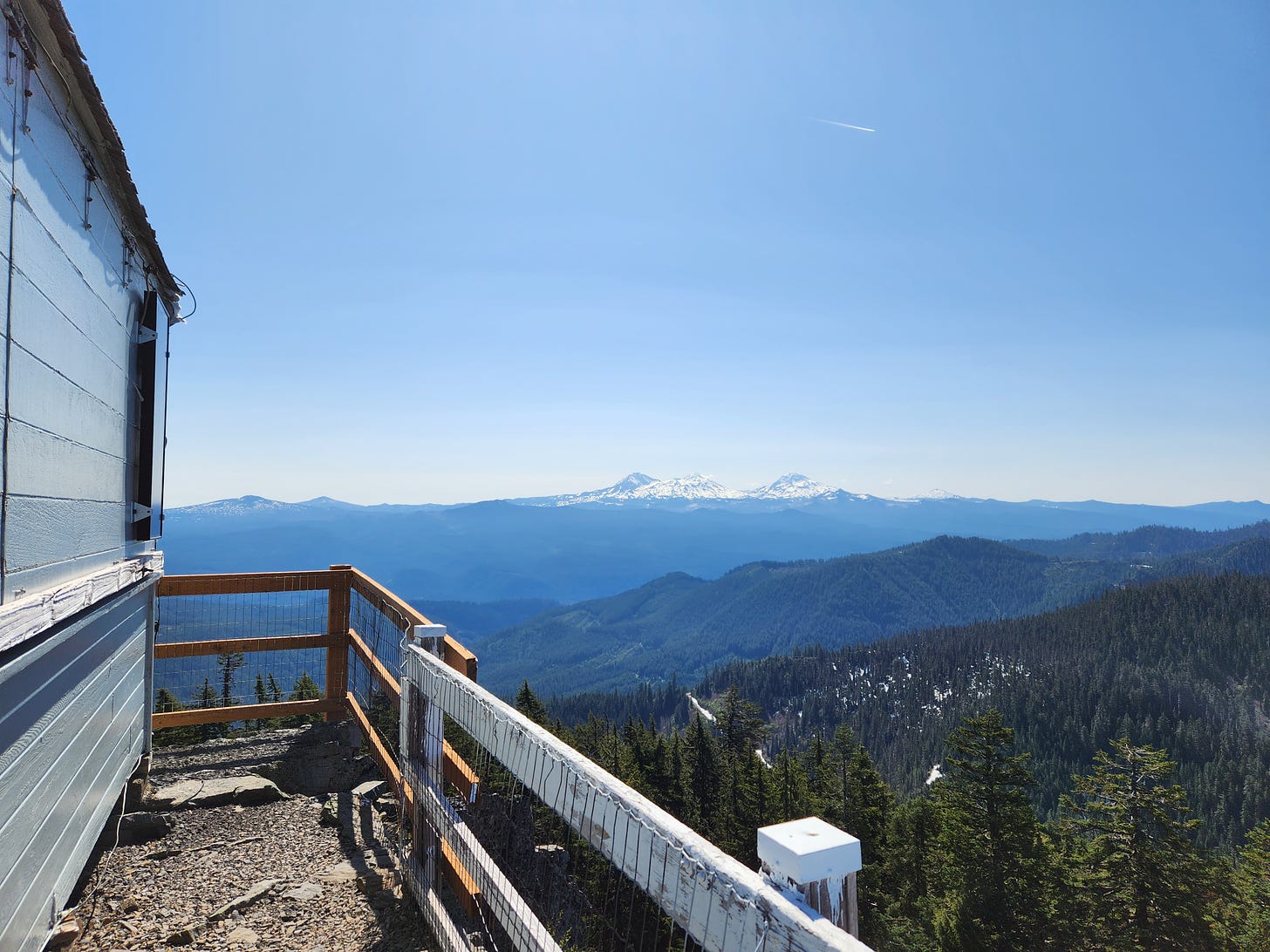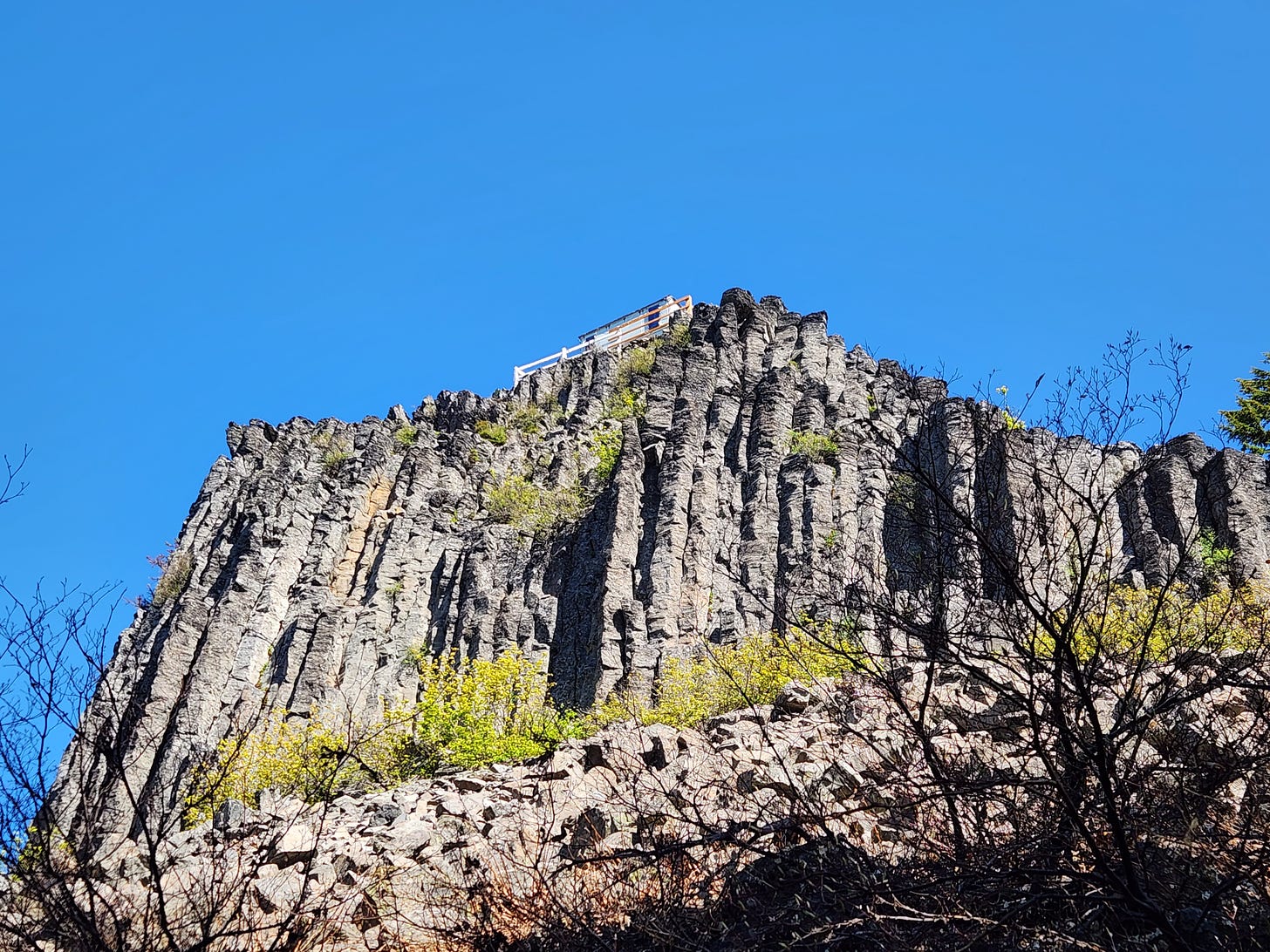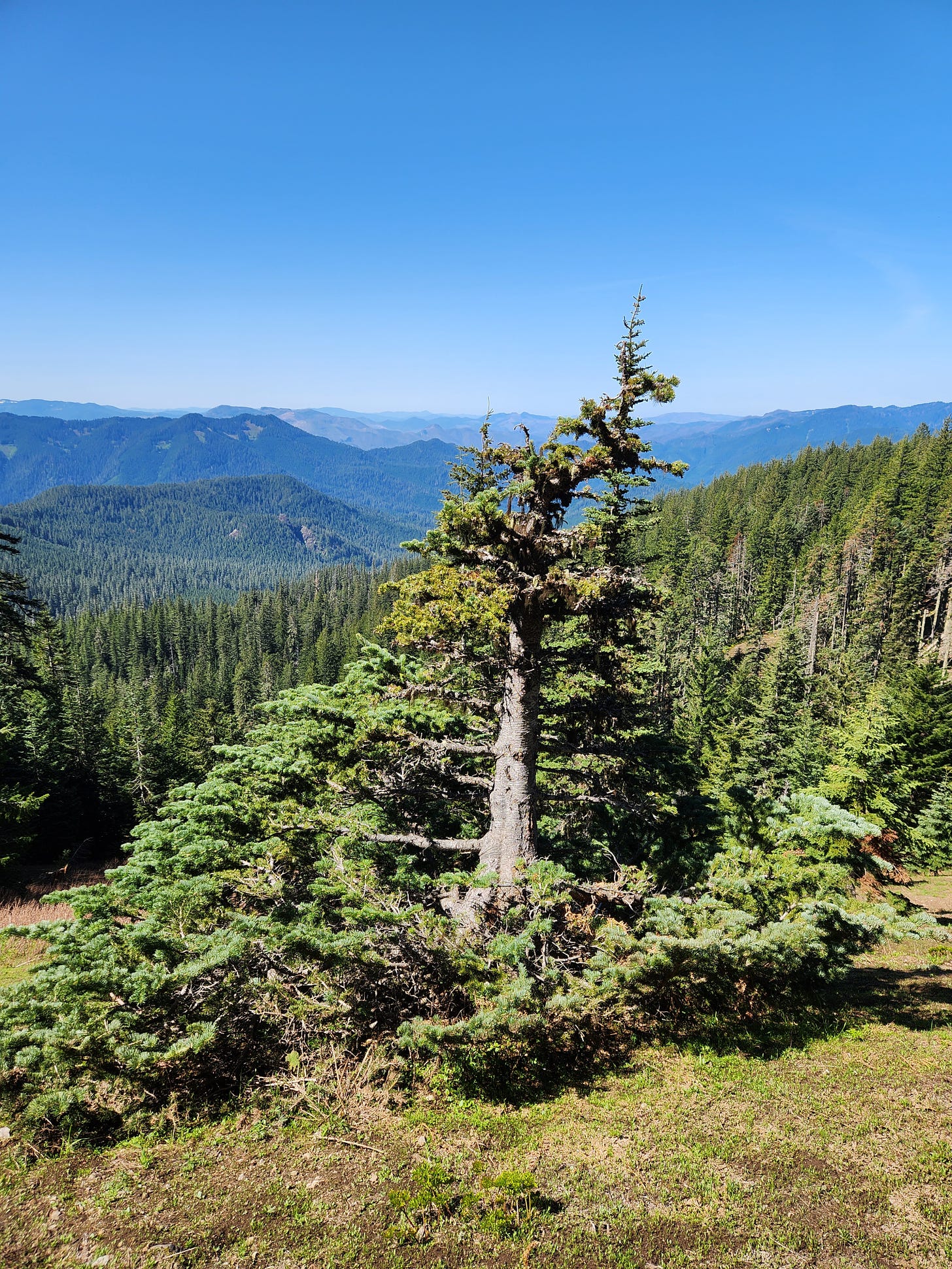Last week, I shared a thumbnail sketch history of the H. J. Andrews Experimental Forest where I just finished a two-week writing residency. This week, Taking Bearings turns to The Field Trip, so I’ll share a short trip that capped my time there.
To Carpenter Mountain Lookout
Before I arrived at the Andrews, I did not know a fire lookout marked the northeast corner of the experimental forest. At roughly a mile high, the lookout sounded like the right place to get the lay of the land. My first free morning, I made a beeline for the trailhead.
The Andrews is no wilderness. Roads criss-cross the almost-16,000 acres, so it was easy to reach the trailhead, one of only two or three officially designated trails on the forest. This road, though, rose quite a bit into the shaded woods, and I was surprised to find a patch of snow and then another one covering part of the road. The snow didn’t stop me from getting to the trailhead (although the road continued around a bend into a snowbank).
After parking, I looked east and the Cascades loomed as far north and south as I could see. The Three Sisters peaks were most prominent, clustered straight ahead. Lest I get too distracted by views and puzzling out which peaks were which, I hit the trail. It only stretched a mile, but I had other plans for the day and couldn’t dally. Immediately I encountered snow. I had not planned on that, but enough clues remained I could follow the trail until the snow petered out after a quarter-mile or so.
I climbed easily, hit a switchback in the trees, and then saw the lookout, perched atop a block of basalt. From below, it looks fortress-like. The trail wound around the base and then up through the rocks. The last few feet were not much more than a scramble. Greeting me was an office chair without a back, the origin story of which I’ve wondered about (and invented) ever since.

No one staffed the lookout, although later in the season, someone will.
What’s a Lookout for?
Like many fire lookouts, this one was built in the 1930s (although an earlier one had existed beginning in 1917). I can’t confirm it, but it is likely the Civilian Conservation Corps built it, something the CCC did often.
Carpenter Mountain Lookout is on the Willamette National Forest, and the US Forest Service early on developed a strong antipathy to fire. The agency originated in 1905 and was tested by massive fires in 1910 on lands it “controlled” in Idaho and Montana. Millions of acres burned, along with towns. The agency’s unofficial raison d’être became protecting forests from wildfire.
By the time the Carpenter Mountain Lookout was constructed, the 10:00 am policy guided the Forest Service. It was simple: every spotted fire should be extinguished by the next morning at 10:00 am. The aspirational policy repeated until satisfied. For an agency that protected trees, stopping fires made intuitive sense.
We have learned that fires play key components in forest ecology. (Others knew this already.) In some forests, fires are necessary to germinate seeds. In others, frequent fires maintain what is sometimes called forest health. In still others it is less frequent but equally essential. This does not mean all fires should be allowed to burn, of course. But fire suppression through much of the 20th century – the reason fire lookouts like this one dot high spots in mountains – has a complicated legacy that has undermined forest resilience and exacerbated wildfire risk.

Imagining More at Lookouts
I have been to several lookouts, and their settings prompt something reverential. You can see a long way, literally and perhaps figuratively.
Famously, Jack Kerouac staffed a fire lookout in the North Cascades, not far from where I live. Desolation Angels was one product of that time. Gary Snyder did too. “Mid-August at Sourdough Mountain Lookout” was a product of that time, a short poem which includes lines that capture this high-up vision:
Drinking cold snow-water from a tin cup
Looking down for miles
Through high still air.
Although the responsibility to spot fires when they start is a great one, being atop a mountain, you sense, is also something more than a job.
At least I think so.
As I often do, while I walked around the lookout, I imagined what it would be like to work there, now and in the past. Some might call this daydreaming, and I would understand that charge. But I think I’m doing something more. I’m honing historical empathy when I consider how earlier people would have understood this view and the task before them. And I’m honing an environmental empathy perhaps too, which I think can be done on a landscape scale with views like this (or miniature scale by contemplating the details of trillium or Indian paintbrush).
I scanned the Andrews and beyond, marking the territory at least in my mind, considering the mountains and the trees and the trees that used to be.
Close by, in September 2020, the Holiday Farm Fire broke out and rapidly spread down the McKenzie River Valley. This lookout must have had the most terrifying view of the fire that ultimately burned almost 175,000 acres and nearly 800 structures as it raced west.
The near forest remains green, and I looked down and still saw fields of snow. But in the days at the Andrews news reached me of terrible smoke in the northeast. Our new age evolved from our current and past one. Developing empathies will not solve all our problems but will help. It may even be a precondition to action, for if we do not care, we will not act.
Final Words
In graduate school, I studied with the world’s leading expert in the history of wildland fire, Steve Pyne. Consequently, I’ve been quick to observe fire in my writing. I’ve sprinkled it throughout several books and articles. To highlight just once piece, here is a column I wrote about the intersection of fire and wilderness and the emergence of institutional arguments for allowing fires to burn and even be deliberately set.
Today, my very first story for a daily newspaper appeared in the The Everett Daily Herald, the newspaper that arrived at my home every day growing up. It is about volunteers preserving historical documents out of a Forest Service office. Take a look here to learn about these local history devotees.
As always, you can find my books, and books where some of my work is included, at my Bookshop affiliate page (where, if you order, I get a small benefit).
Taking Bearings Next Week
Still on the forest theme, for next week’s The Library entry, I’m planning to wrap up a novel written in the 1950s about the early 20th century about homesteading and logging in the woods in northern Idaho. Stay tuned!







Nice read! I also liked the column from 2018. Thanks!
What a goldmine of imagery and insights! Thank you for letting me tag along.
And hearty congratulations on the feature in the Everett Herald.; a story beautifully told. Loved the High Country news article, too. May need to reach out to you to talk fires for a project I'm working on.